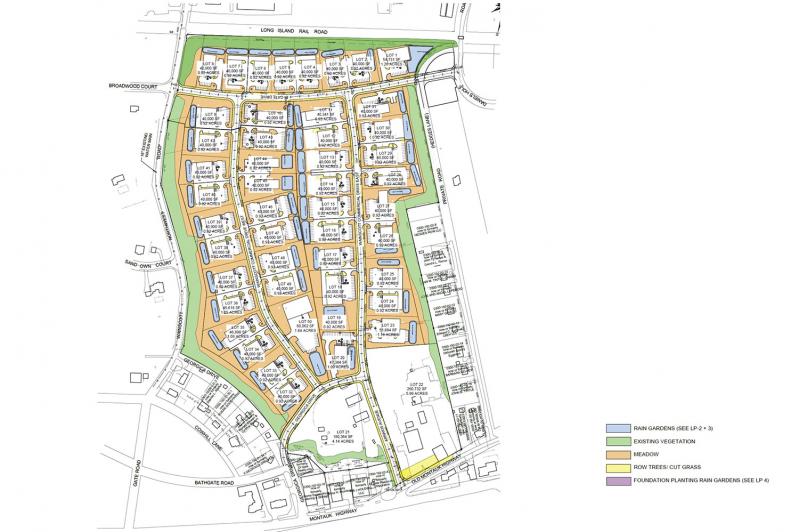The largest development proposal in the Town of East Hampton, the proposed Wainscott Commercial Center at a 70.4-acre former sand mine at the west end of town on Route 27, drew over 50 speakers and 150 comments during a public hearing on its draft environmental impact statement in February 2023, most of whom were critical of the project.
Then it dropped off most people’s radar.
Last week it returned, and in a sort of reintroduction to a largely new planning board, the Planning Department gave a short recap of the project and what has transpired since the hearing.
Peter Feroe, a consultant from A.K.R.F. who is working with the town, presented an overview. He told the board that John Tintle, who owns the site through a number of limited liability companies, proposes to subdivide the 70 acres into 50 commercial lots. Two existing uses would remain on the southern portion of the property while the other commercial lots would be sold. Each lot would need to undergo a separate site plan approval, meaning it would be up to each new owner to place a septic system, parking, and locate the desired buildings. New roadways, utilities, and drainage systems would be part of the development.
Turns out, the main sticking point from early 2023 is the same sticking point in early 2025. After the public hearing, the Planning Department told Mr. Tintle that a supplemental environmental impact statement was needed to bolster the information included in the roundly criticized draft environmental impact statement. In May of 2023, the East Hampton Town Zoning Board of Appeals dealt Mr. Tintle another setback when it told him a special permit for the planned commercial-industrial park would be required.
The application received scrutiny not only from residents and the town’s Planning Department, but also from the Federal Aviation Authority (because of its proximity to the airport), the Suffolk County Water Authority (which said it has sufficient water capacity to serve the project), the New York State Department of Environmental Conservation, and the Suffolk County Planning Commission (which asked for an updated traffic study). Comments from the Suffolk County Department of Health Services, however, stood out.
According to Mr. Feroe, the Health Department asked for “an analysis of any and all alternative wastewater treatment disposal methods,” as well as “additional soil and groundwater investigations, and they recommended the incorporation of additional mitigation measures to address any subsurface contamination.” These requests were in line with concerns raised at the public hearing about how potentially contaminated groundwater and stormwater runoff could impact Georgica Pond, only a few hundred feet away.
Mr. Tintle disagreed about the need for a supplemental environmental impact statement and has fought against producing one. In the meantime, his attorneys have continued to accuse the Planning Department of delay tactics. At the meeting, he said that only two members of the seven-member board were there when he first submitted the plans, seven years ago.
“We retained New York litigation counsel, who, after reviewing the record of this application, have advised us that the above timeline clearly constitutes dilatory tactics by the Planning Department and this board, designed to dissuade my family from pursuing this application,” he said.
However, after the public hearing in 2023, Mr. Tintle requested an adjournment of the application while he and his team worked through some of the town’s comments. Timelines that are part of the New York State Environmental Quality Review Act were paused. Then, just before Christmas 2023, Mr. Tintle’s team handed the town a sort of unwelcome gift, an 800-page submission, which neither the planning board nor Planning Department had requested.
That submission included the application for the special permit required by the Z.B.A. and a new traffic study, but it also included an argument that the supplemental environmental impact statement was not required because the planning board lacked authority “or the basis to require additional subsurface environmental testing.” A tit-for-tat ensued on how to address the 150 public comments. After the Planning Department digested the 800 pages, three meetings, which Mr. Feroe characterized as “difficult” at times, were held last summer. Along with a certain amount of teeth gnashing, Mr. Tintle’s team agreed to provide some additional information to the Planning Department on wastewater alternatives, nitrogen loading, mitigation measures for polluted groundwater, and a new noise study. However, he and his team still resisted producing the supplemental impact statement.
“I’d like to suggest that the most reasonable path forward is the hamlet plan alternative that is included and extensively discussed in the D.E.I.S.,” Mr. Tintle told the board. “To date, the hamlet plan alternative has been completely ignored by the Planning Department.” He said while his proposal has been criticized for not incorporating recommendations of the hamlet plan, which would have it include a public park, affordable housing, and a train station, it is “inconsistent with the longstanding zoning classification for the site and therefore is beyond a private party’s legal ability to implement. The only legal way for the town to develop a park at the site is for the town to purchase a portion.”
“We do not comment on ongoing planning board proceedings,” said Patrick Derenze, the town supervisor’s public information officer, when asked if anyone on the town board would comment on whether the town is considering purchasing a portion of the site.
After the meeting, the planning board was up to speed. Up next for board members will be to decide whether they agree with the Planning Department that Mr. Tintle needs to provide an S.E.I.S.
“S.E.I.S. or no S.E.I.S?” said Ed Krug, the board chairman, previewing the next planning board discussion, slated to occur before this spring.




